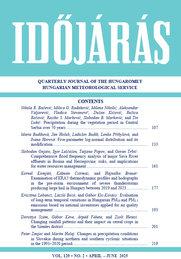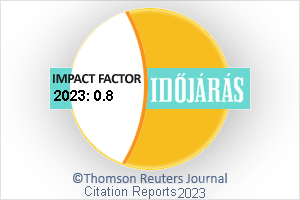IDŐJÁRÁS - angol nyelvű folyóirat
Vol. 129, No. 2 * Pages 107–240 * April - June 2025
 |
|
 letöltés [pdf: 2963 KB]
letöltés [pdf: 2963 KB]
Precipitation during the vegetation period in Central Serbia over 70 years
Nikola R. Bačević, Milica G. Radaković, Milena Nikolić, Aleksandar Valjarević, Vladica Stevanović, Dušan Kićović, Ružica Božović, Rastko S. Marković, Slobodan B. Marković, and Tin Lukić
DOI:10.28974/idojaras.2025.2.1 (pp. 107–132)
Nikola R. Bačević, Milica G. Radaković, Milena Nikolić, Aleksandar Valjarević, Vladica Stevanović, Dušan Kićović, Ružica Božović, Rastko S. Marković, Slobodan B. Marković, and Tin Lukić
DOI:10.28974/idojaras.2025.2.1 (pp. 107–132)
Five-parameter log-normal distribution and its modification
Marie Budíková, Jan Holub, Ladislav Budík, Lenka Přibylová, and Ivana Horová
DOI:10.28974/idojaras.2025.2.2 (pp. 133–160)
Marie Budíková, Jan Holub, Ladislav Budík, Lenka Přibylová, and Ivana Horová
DOI:10.28974/idojaras.2025.2.2 (pp. 133–160)
Comprehensive flood frequency analysis of major Sava River affluents in Bosnia and Herzegovina: risks, and implications for water resources management
Slobodan Gnjato, Igor Leščešen, Tatjana Popov, and Goran Trbić
DOI:10.28974/idojaras.2025.2.3 (pp. 161–175)
Slobodan Gnjato, Igor Leščešen, Tatjana Popov, and Goran Trbić
DOI:10.28974/idojaras.2025.2.3 (pp. 161–175)
Examination of ERA5 thermodynamic profiles and hodographs in the pre-storm environment of severe thunderstorms producing large hail in Hungary between 2019 and 2023
Kornél Komjáti , Kálmán Csirmaz, and Hajnalka Breuer
DOI:10.28974/idojaras.2025.2.4 (pp. 177–191)
Kornél Komjáti , Kálmán Csirmaz, and Hajnalka Breuer
DOI:10.28974/idojaras.2025.2.4 (pp. 177–191)
Evaluation of long-term temporal variations in Hungarian PM10 and PM2.5 emissions based on national inventories applied for air quality management
Krisztina Labancz, László Bozó, and Gábor Kis-Kovács
DOI:10.28974/idojaras.2025.2.5 (pp. 193–200)
Krisztina Labancz, László Bozó, and Gábor Kis-Kovács
DOI:10.28974/idojaras.2025.2.5 (pp. 193–200)
Changing rainfall patterns and their impact on cereal crops in the Szentes district
Dorottya Szám, Gábor Keve, Árpád Fekete, and Zsolt Hetesi
DOI:10.28974/idojaras.2025.2.6 (pp. 201–217)
Dorottya Szám, Gábor Keve, Árpád Fekete, and Zsolt Hetesi
DOI:10.28974/idojaras.2025.2.6 (pp. 201–217)
Changes in precipitation conditions in Slovakia during northern and southern cyclonic situations in the 1991–2020 period
Peter Zaujec and Martin Halaj
DOI:10.28974/idojaras.2025.2.7 (pp. 219–240)
Peter Zaujec and Martin Halaj
DOI:10.28974/idojaras.2025.2.7 (pp. 219–240)
IDŐJÁRÁS folyóirat

Az IDŐJÁRÁS a HungaroMet Nonprofit Zrt. negyedévenként megjelenő angol nyelvű folyóirata
Megrendelhető a journal.idojaras@met.hu címen.
A szerzőknek szánt útmutató itt olvasható.
Megrendelhető a journal.idojaras@met.hu címen.
A szerzőknek szánt útmutató itt olvasható.









